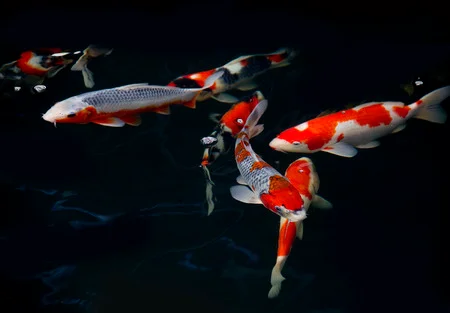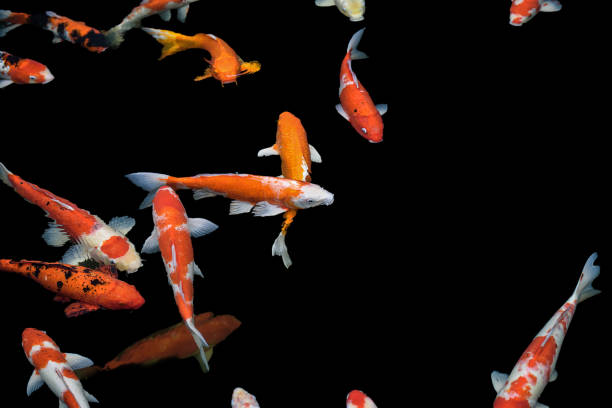Have you ever wondered if koi fish are cold-blooded? Koi have captivated people for centuries with their beautiful colors and patterns, so it’s no wonder many want to learn more about them.
In this blog post, we’ll explore the science behind koi anatomy and answer the question: Are koi fish cold-blooded? Read on to find out!
What is Cold-Blooded?
Cold-blooded, or poikilothermic, is a term used to describe animals whose internal body temperature is affected by the temperature of their environment.
This means that the metabolic rate of a cold-blooded animal can vary depending on its environment. This contrasts with warm-blooded animals, who can maintain a constant body temperature regardless of their environment.
Cold-blooded animals tend to be more active and have a higher metabolism when exposed to warmer temperatures, and become sluggish and have a lower metabolism when exposed to cooler temperatures.
Are Koi Fish Cold-Blooded?

Yes, koi fish are cold-blooded creatures. This means that the ambient temperature of their environment determines their body temperature.
This type of animal is known as poikilothermic or ectothermic. This means that the koi’s metabolism, activity level, and overall health are affected by the temperature of the water they live in.
In colder weather, they become less active; in warmer weather, they become more active. In the wintertime, their metabolism slows down, and they become less active as the water temperature drops.
How Do Koi Fish Adapt to Temperature Fluctuations?
This makes them incredibly adaptable when it comes to temperature fluctuations. In the summertime, when the water is warmer, their metabolism speeds up, and they become more active, whereas, in the wintertime, their metabolism slows down and becomes less active.
This means they can survive in water temperatures that may be too cold for other fish species. This also makes them ideal for outdoor ponds that may experience various temperatures during different seasons.
How are Koi Fish Affected by Winter Weather?
The cold-blooded nature of koi means that they rely on their environment to regulate their body temperature, and they can become sluggish, sick, or even die when the water drops too low.
During winter, koi enter a state of hibernation, where their metabolism slows down, and their activity level decreases significantly. As the water temperature drops, koi will seek out warmer spots in the pond and may even move to deeper areas to find more heat.
For koi to survive the winter, their pond must be equipped with a heater or other water heating methods. This will ensure that the water does not drop below a dangerous temperature for koi and that they have enough oxygen to survive.
What Conditions do Koi Need to Survive in Cold Temperatures?

Koi are cold-blooded species, so their body temperature is approximately 1 degree C above the water temperature they are in. They have cold-blooded bodies, meaning their metabolism is extremely sensitive to their environment.
When the pond’s temperature drops, its metabolism also slows down; as a result, they require less oxygen and food. To survive in cold temperatures, koi need a pond with enough oxygen and food to sustain them.
They also need a pond with a thick layer of ice to prevent the cold air from reaching the water. If these conditions are met, koi can survive in the coldest temperatures.
How Can You Tell if Your Koi Need More Heat or Cooler Water During Different Seasons?
Koi are poikilothermic, which means their body temperature can fluctuate depending on the temperature of the water. It’s important to monitor your koi during different seasons and adjust their water temperature accordingly.
A good way to determine if your koi needs more heat or cool water is to check the water temperature with a thermometer. If the temperature is too high, add ice cubes to the pond or use a water chiller to lower the temperature.
If the temperature is too low, you can add a heater to raise the temperature. You should also monitor your koi’s behavior during different seasons to ensure they are healthy and active.
Conclusion
In conclusion, koi fish are cold-blooded animals that can survive in cold temperatures. They rely on the temperature of the water they live in to regulate their metabolism.
During winter, when the water in your pond is ice cold, the koi’s metabolism slows down to adapt to the environment. To ensure that your koi survive winter, it is important to ensure enough oxygen in the water.
Additionally, you should monitor the pond’s temperature during spring and fall when the temperatures fluctuate and make adjustments accordingly. You can ensure that your koi fish survive the cold winter weather with proper care.




